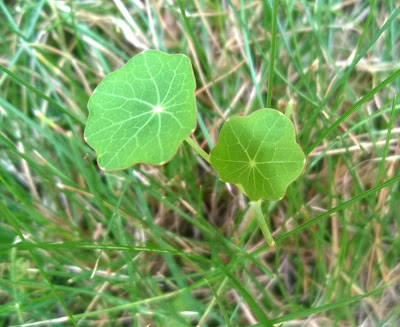Nasturtium (Indian
cress, lat. Tropaeolum majus) was first introduced from Peru to Europe in the
1600s. It was used as a medicinal plant for a long time in South America.
Nasturtium is
an easy-to-grow annual whose leaves and flowers are edible. It can act both as a disinfectant
and a healing
agent, and all parts of the plant seem to have strong antibiotic
and antimicrobial
properties. These orange, yellow, and red flowers are sweet and
tangy, yet peppery and spicy flavor.
Nasturtiums
are actually fabulous plants. They are ridiculously easy to grow, and you can
eat their colourful flowers, leaves and seeds.
In addition
to its wonderful flavor, the nasturtium plant is a rich source of immunity-boosting vitamin C
and is reputed to contain an herbal equivalent of penicillin, which helps
the body fight off infection.
It is
excellent for treatment of urinary tract infections, swollen airways, cough, cold,
bronchitis, influenza and influenzal pneumonia. It helps in the treatment
against 46 strains of Staphylococcus aureus (MRSA) and Streptococcus. It is far
safer than orthodox antibiotics as it produces no resistance or allergy.
Nasturtium can
be applied directly to the skin for mild muscular pain and to treat minor
scrapes and cuts. It also works against
various fungal infections, including yeast infection.
The dried
ripe buds have a strong laxative effect and unlike many conventional
germicides, nasturtium will not damage the intestinal flora.
Nasturtium
has a reputation for promoting the formation of red blood cells, and it’s been
used in folk medicine as a remedy against scurvy.
The herb has
been used as a remedy for hair loss and to stimulate hair growth.
The main substances
found in Nasturtium:
·
Glucosinolates - Plants producing
large amounts of glucosinolates are under basic research for potential actions
against cancer.
·
Mustard oil - has high levels of both Alpha-linolenic
acid (ALA) and Erucic acid.
·
Flavonoids - anti-allergic,
anti-inflammatory, antioxidant, anti-microbial (antibacterial, antifungal,
antiviral), anti-cancer, and anti-diarrheal activities
·
Carotenoids
·
Vitamin C
Nasturtium Tincture:
Finely
chopped flowers and leaves put into a small bottle and pour with alcohol (60%),
close it , store it in a dark place for 3-4 weeks and sometimes shake with it.
Dosage - 3 x day 20 drops for adult, 5-10 drops for
children into a hot tea.
Possible Side Effects and Interactions of Nasturtium
Nasturtium
contains mustard oil and when used topically can cause skin irritation.
Long term
intake of Nasturtium may reduce fertility.
Pregnant or
breastfeeding women should not use this herb. People with kidney diseases or
ulcers of the stomach or intestinal tract should not use this herb in any form
either.
Warning: Health
information and the names of the drugs mentioned in the article are only for
orientation in the field of self-medication and does not replace communication
with your doctor. Before taking any medication, read the leaflet or ask your
pharmacist or doctor. The author is not responsible for misinterpretation of
the information contained on the website and is not responsible for any damages
incurred subsequent procedures or conduct that are made based on the content of
these pages. By
entering this blog you confirm that you have read the aim and the restrictions
of the site.

No comments:
Post a Comment
Your comment is welcomed